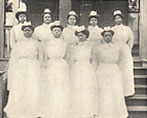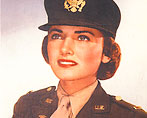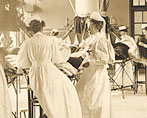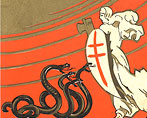Education
Pictures of Nursing presents the following classroom resources for K-12 and undergraduate educators and their students. The resources offer examples of how the rich content and primary sources in the exhibition can be used to promote students’ developing higher order thinking skills, in addition to expanding subject-area knowledge. Educators are welcome to adapt these resources in whole or in part as they deem appropriate for students’ interests and learning goals.
Lesson Plans
Visual Literacy: Images of Nurses and Nursing
- Grade level: 9–10
- Subject: History and social studies
Students use four nursing postcards from the Pictures of Nursing website in order to develop and practice visual literacy skills. They examine the postcard images and critically evaluate how each image depicts, and even shapes, social perception of nurses and nursing. Students also consider them in historical and social context based on their observations of the images and prior knowledge. Working on the image analysis tasks, students specifically articulate their observations and inferences that support their analysis work.
This lesson plan is developed with contributions made by the following 2013 Teacher Institute participants: Samantha Candia (Francis Scott Key Middle School, Silver Spring, MD), Sarah Elwell (McKinley Technology High School, Washington, DC), Lory Gardnder (Montgomery Village Middle School, MD), Amber Leber (Montgomery Village Middle School, MD), and Emily Sigman (Poolsville High School, MD).
Higher Education
Picture Perfect Images and Realities of Military Nursing During the World Wars
The module encourages students to consider the complex relationship between idealized American gender roles, wartime propaganda, and female military nurses’ real experiences during World War I and World War II. Historically, Americans have viewed nursing as a feminine profession. While nurses and other women have always been involved in US military actions, during the two World Wars the government began to officially incorporate women into the armed forces. Most Americans at the time considered the military a masculine institution and therefore, an inappropriate place for women. Consequently, these changes in policy resulted in some societal backlash. However, unlike regular servicewomen, military nurses were often spared public criticism, due to the feminine status of the nursing profession. The government employed propaganda to further the idea that military nursing was a feminine pursuit and to minimize any negative public reactions against nurses in the armed forces. The module uses the exhibition as a starting point and builds upon it using readings, primary sources, and discussion questions designed to explore how nurses have been depicted in American culture overtime, and how those perspectives have changed in conjunction with historical events and evolving notions of popular femininity. The goal is that the module will deepen students’ understanding of the intricacies of gender roles, labor, media, and change over time, as well as encourage students to think critically about these elements historically and in their everyday lives. This module is authored by Loren Miller, a Ph.D. candidate in History at American University, Washington DC.
Online Activities
Florence Nightingale Letters
View and read four letters written by Florence Nightingale in 1855—56 while she cared for wounded British soldiers in the Turkish region of the Ottoman Empire during the Crimean War.
To Serve at Home and Abroad
Take a look at the imagery and words on a 1914 recruitment poster that called British women to volunteer to aid the country’s fight in World War I. Consider how it offered similar or new experiences and opportunities to them.
Nurses: Pictures of Service and Pride
Examine these postcard images of US nurses from the last century. Then create a collage that depict how nurses served and forged their profession in the past.
Other Resources
Continue to explore many topics related to nurses’ lives and the nursing profession with these lists of suggested K-12 readings and online resources, and curator’s bibliography.
Continue to Other Resources






